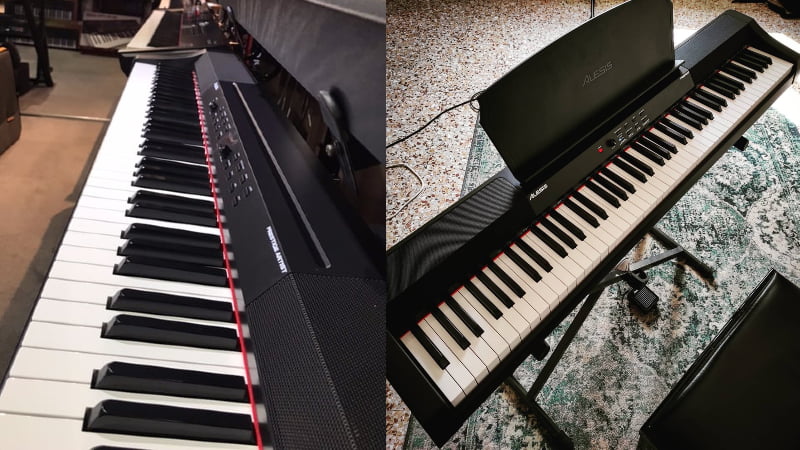When comparing the Alesis Prestige vs Prestige Artist, the Alesis Prestige Artist was the easy winner. Considering that it’s the upgraded version for more advanced pianists, the Alesis Prestige Artists comes with a great set of features, a killer tone, and a variety of reverb effects that musicians can use to tweak and customize their sound.
The Alesis Prestige, on the other hand, is still one of the best beginner digital pianos out there. Now called the Alesis Recital Grand, this piano is affordable, comes with great tone, realistic feel, and a fair amount of playing modes that make it a top option for beginners.
But in the end, the Alesis Prestige simply couldn’t hold its own against the Prestige Artist. As the upgraded version, the Alesis Prestige Artist takes all the best parts of the older model and improves on all the features customers found lacking.
Alesis Prestige vs Prestige Artist: Comparison Chart

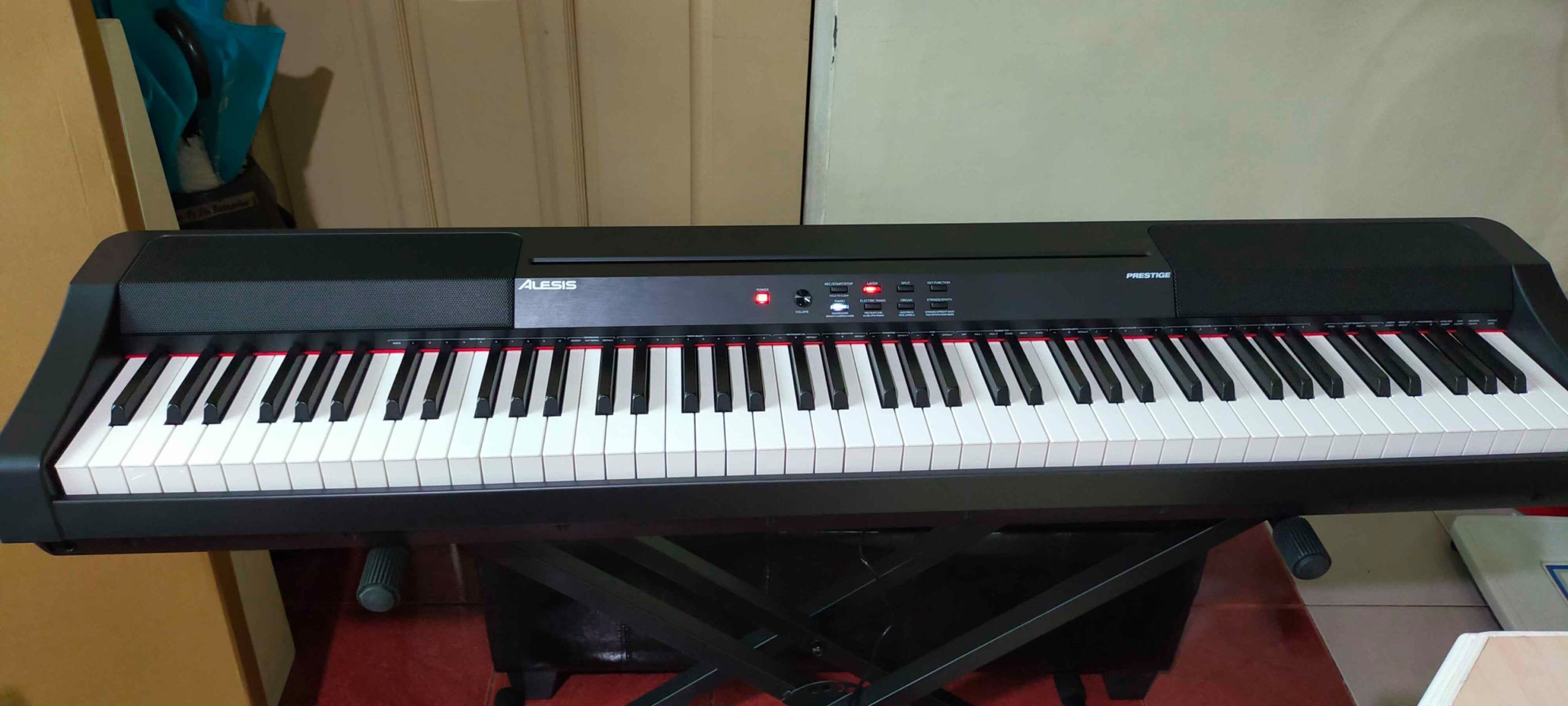


Last update on 2025-07-05 / Affiliate links / Images from Amazon Product Advertising API
Alesis Prestige vs Prestige Artist: Differences
When trying to figure out the winner between the two, I decided to compare all their features against each other. And as expected, the Prestige Artist came out on top with a score of 4-1. Since the Prestige Artist is geared towards more advanced pianists who are starting to perform on stage, it comes with more robust features such as better polyphony, effects, and a wider sound library.
Feel
The winner: Tie
Between these two pianos, it was hard to tell the difference when it came to feel. Since they are equipped with the same hammer action, keys, and even touch sensitivity, they are absolutely tied in this regard.
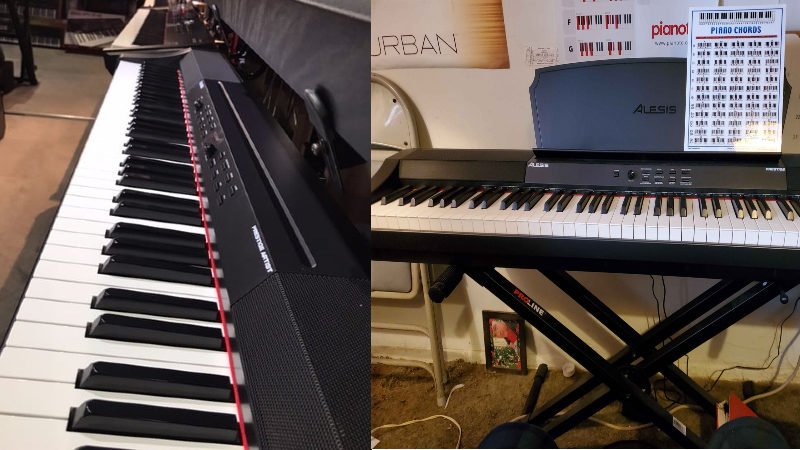
+ Hammer Action
One of the reasons the original Alesis Prestige grew in popularity was because of its hammer action. The Alesis Prestige and the Prestige Artist both sport graded hammer action, which is designed to mimic the feel of an acoustic piano. This feature is a great surprise for the Prestige as it’s usually a feature reserved for more expensive models like the Prestige Artist or the Yamaha P125.
Graded hammer action replicated an acoustic piano by having heavier keys on the bass notes which get lighter as you go up the keyboard. When trying out these pianos, I found that the hammer action was a bit on the heavier side, which isn’t really a problem, as the ideal hammer action is more up to personal preference than anything else.
+ Touch Sensitivity
Both of these pianos have three different touch sensitivities: hard, medium, soft, and fixed. You can choose between anyone of these sensitivities to reflect your playing style. Just like with hammer action, the right touch sensitivity for you depends on your personal preferences and play style.
The Alesis Prestige and the Alesis Prestige Artist have the exact same touch sensitivity technology. So, between the two, there is no winner in this regard.
+ Key Finish
The key finish of these pianos is something I found greatly lacking. Again, there are some pianists who might enjoy a glossier finish, but these do not replicate the texture of an acoustic piano. When playing the piano, I could definitely feel the glossy finish and found myself wishing for keys that better resemble wood.
However, if you’re a beginner, there’s a high chance you won’t notice the difference. Afterall, the key finish makes the biggest difference when playing very fast pieces, which most beginners won’t find themselves doing at all.
Tone
The winner: Alesis Prestige Artist
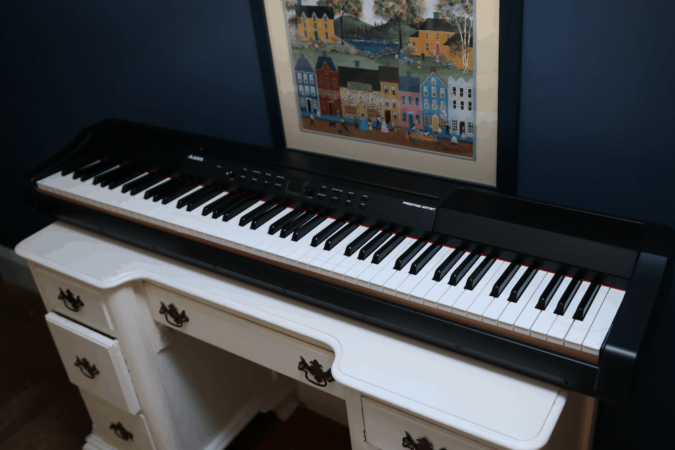
In terms of tone, I have to admit that this was a pretty close fight. The Alesis Prestige Artist shares the same tone generation technology as the Alesis Prestige, which means a lot of their voices sounded very similar, if not identical. However, in the end, I found that the Alesis Prestige artist was the winner simply because it offered more tone and voice presets, giving the player much more flexibility.
+ Tone Generation
The tone generator on both these pianos is based on sampling technology. The main difference is that it uses multiple-sample layering to get a more realistic tone. For each key you press on the piano, you trigger multiple different stereo samples of the same note to better replicate the acoustics of an acoustic piano. This is much better than a lot of other digital pianos out there that only play one sample per note and it makes for a much richer and bodler overall tone.
Both the Alesis Prestige and the Prestige Artist have a great collection of tones. The high-quality samples recorded for each single note are top of the line, and each piano sports tone good enough to compete with some of the more expensive models out there.
+ Sound Library
The main reason the Alesis Prestige Artist was the winner in terms of tone is because of its sound library. Right out of the box, the Prestige Artist comes with 30 different voices. These include a collection of piano, bass, synth, strings, and other tones. Because of Alesis’ top-quality sampling technology, each one of these tones sounds great and offers players a lot of flexibility and versatility when playing. If you’re a performing musician or just a pianist who enjoys playing with different sounds, the Alesis Prestige Artist is definitely the option for you.
The Alesis Prestige only comes with 16 tones. Now, don’t get me wrong, this is still better than a lot of other models in its range such as the Yamaha P45 which only comes with 10 different voices. However, this simply doesn’t match up to the wide variety of different sounds available on the Alesis Prestige Artist, which is why it was the runner up when it comes to tone.
Piano Features
The winner: Alesis Prestige Artist
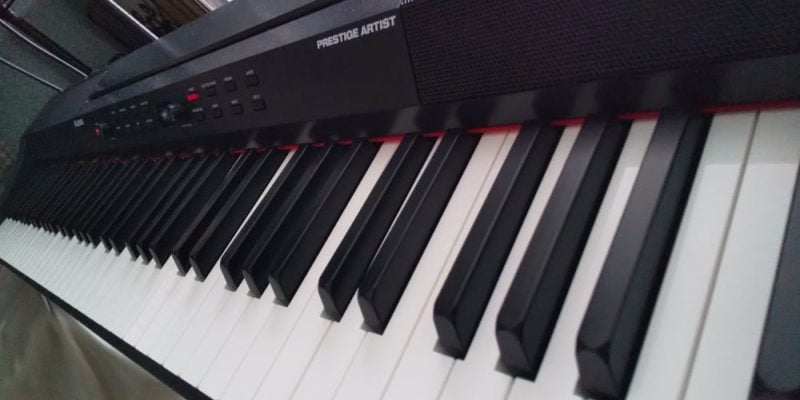
This was one area where the Alesis Prestige Artist was the clear winner. Because of its robust set of reverb effects, superior polyphony, and a couple of cool extras and playing modes, it easily beat out the Alesis Prestige.
+ Effects
To start, the Alesis Prestige comes with no effects. With that said, this isn’t necessarily a deal-breaker. When you’re starting out your piano journey, you won’t be too particular about the tone and sound of your instrument. So, you don’t need a piano with a wide set of different effects since you probably won’t end up using the effects, anyway.
However, effects are still great to have. On the Alesis Prestige you can toy around with 4 different reverb effects. These reverb effects are designed to emulate the natural reverb of different locations such as a hall or church. This is a great way to add depth to your tone and create a more realistic sound that will surely wow your audience.
+ Polyphony
For most beginner pianos, polyphony isn’t that important as long as it’s above 64. However, since the Alesis Prestige and the Prestige Artist play multiple samples whenever you press a note, polyphony is very important. For these pianos, you would want a larger maximum polyphony since that will allow you to play wider and denser chords with a lot of notes.
The Alesis Prestige has 128 note maximum polyphony. This isn’t bad at all, and for beginners, it’s very good. This is because you likely won’t need to play wide and dense chords at the beginning of your journey, and 128 note maximum polyphony is more than enough to handle most beginner pieces, even with the sustain pedal.
With that said, the Alesis Prestige Artist doubles that polyphony. This model comes with a maximum polyphony of 256. This is much better than the Alesis Prestige, and allows you to fully experiment with a variety of different chords and voices in your playing. This is a great feature especially for performing pianists, who need to find unique sounds, chords, and melodies for their performances.
+ Playing Modes
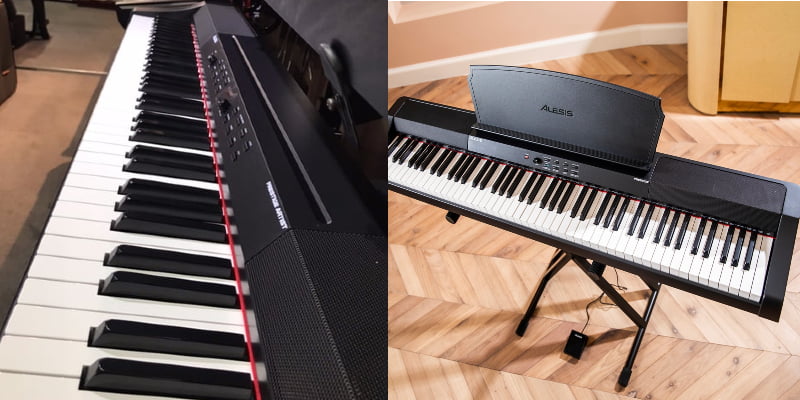
When it comes to the different playing modes, both of these pianos come with great options. In fact, I’d even say they’re tied when it comes to the different playing modes. This is because both the Alesis Prestige and the Prestige Artist come with split, layer, and lesson mode.
Split mode is great for performing as it divides the piano into zones with different voices. An example of using this in a live setting is to have a bass voice on the left side and a piano voice on the right side. That way, you can hold down the groove while also playing chords on top with the piano voice.
Layering mode layers two different voices on top of each other. This allows for a very unique sound that is instantly recognizable. However, while the Alesis Prestige comes with this feature, the Prestige Artist does it much better. This is because the Prestige Artist comes with better polyphony, allowing it to handle the wide variety of notes much better.
Another cool feature is lesson mode. This mode splits the piano into two equally tuned mini-keyboards. This is ideal for piano lessons as you can use the mode in a way that allows both the teacher and student to have their own mini piano. That way, they can play along with each other and the teacher can demonstrate different techniques without their hands crossing over. You can also use this mode for cute piano duets on the same keyboard.
Lastly, both of these options come with recording mode. This mode is best for rehearsing and listening to your own playing after, looking for places to make adjustments. However, if you plan on recording a piano instrumental album, this mode won’t exactly work, since the recordings won’t be that high-quality.
User Interface
The winner: Alesis Prestige Artist
The last area where I found the Alesis Prestige Artist to be the better option is the user interface. The Alesis Prestige Artist comes with an OLED display and knobs for you to navigate through different modes. This works great even for complete beginners, as it allows you to fully explore and experiment with the piano right out of the box.
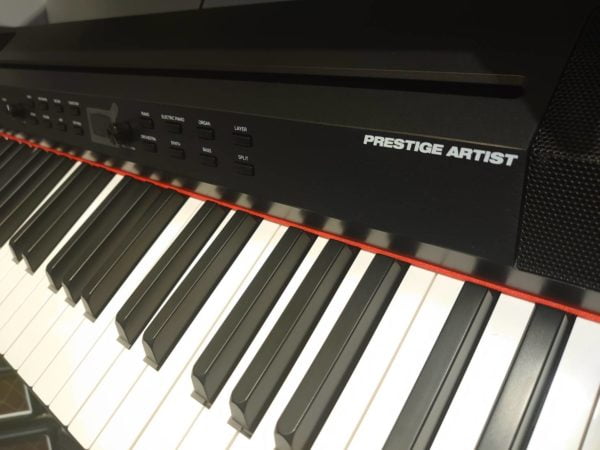
The Alesis Prestige, on the other hand, doesn’t have as good an interface. If you’re familiar with analog gear, the interface of the Alesis Prestige is fine since it consists of a collection of different buttons. However, if you’re more used to having a digital display show you the different modes and parameters, you’re better off with the Alesis Prestige Artist.
Alesis Prestige vs Prestige Artist: The Similarities
Both of these pianos have a fair amount of similarities. Since they come from the same brand and hail from the same product line, you can expect a fair amount of features to cross over each other. For starters, these pianos have the same key texture, hammer action, and touch sensitivity settings. So, if you’re playing the pianos without listening to them, they’ll likely feel exactly the same.
Additionally, these pianos also use the same tone generation technology. So, while the Alesis Prestige Artist comes with more voices, the piano shares a large chunk of its voices with the Alesis Prestige. So, if you’re willing to do away with a couple of extra voices, the Alesis Prestige could be a great way to save money.
Lastly, these pianos have the same playing modes. These include split, layering, and dual mode. All of these playing modes are very useful for piano students and professionals alike, which is what makes these pianos great options for any pianist out there. But since the Alesis Prestige Artist comes with more robust features, it was the clear winner between the two.
Quick Rundown of the Alesis Prestige Artist
- It’s Time to Upgrade your Electric Piano – 88 key piano keyboard with graded hammer action and adjustable touch response for a natural piano feel - for beginner, intermediate and advanced players
- Packed with Premium Sounds - 30 multi-sampled voices including Grand Piano, Electric Piano, Organ, Synthesizers & more; simultaneous Split & Layer modes; built-in arpeggiator; 5 adjustable Reverb FX
- Authentic Playing Experience - 256 max polyphony provides a superb 88 key piano playing experience; 50W micro-array speaker system sounds loud, clear and realistic in any setting
- Stage Piano Essentials – OLED screen for intuitive control; Stereo 1/4” outputs; 1/4” and 1/8” (3.5mm) headphone outputs; USB-MIDI output for use with educational software or virtual
- The Complete Full Size Keyboard Piano Experience - Piano style sustain pedal, music rest, and power adapter included; Lesson & Record Modes to develop your electric keyboard piano skills
Last update on 2025-07-05 / Affiliate links / Images from Amazon Product Advertising API
Quick Rundown of the Alesis Prestige
Product Video
Related Articles to Alesis Prestige Artist
- Alesis Prestige Artist vs Korg B2: The Better $500 Digital Piano
- Alesis Prestige Artist vs Recital Pro: Which Is the Best Alesis Piano for Beginners?
- Alesis Prestige Artist vs Yamaha P125 Comparison: Why the Yamaha P125 Is the Better Investment
- Alesis Prestige Artist vs Yamaha P45: Can Alesis Hold Its Own Against the Popular Yamaha Model?
- Alesis Prestige Artist vs Roland FP-10: Which Is the Best Beginner’s Digital Piano?
Related Articles to Alesis Prestige
References:
- Alesis Prestige 88-key Digital Piano w/ Graded Hammer-action Keys: https://www.sweetwater.com/store/detail/Prestige88–alesis-prestige-88-key-digital-piano-with-graded-hammer-action-keys
- Alesis Prestige Artist 88-key Digital Piano w/ Graded Hammer Action Keys: https://www.sweetwater.com/store/detail/PrestigeArt–alesis-prestige-artist-88-key-digital-piano-with-graded-hammer-action-keys
Lulacruza is an electronic folk duo operating at the junction of the hypermodern and the ancient. Our music weaves together hypnotic female singing, South American folk instruments and electronic processing, while channeling pulsating waves from the source of creation.
Lalucruza is also a community where you can connect with other music lovers to collaborate, exchange ideas and share knowledge. A platform for who wants to learns the basics of playing piano, guitar, drum masters’ technique, etc.. is the premise of our website.
